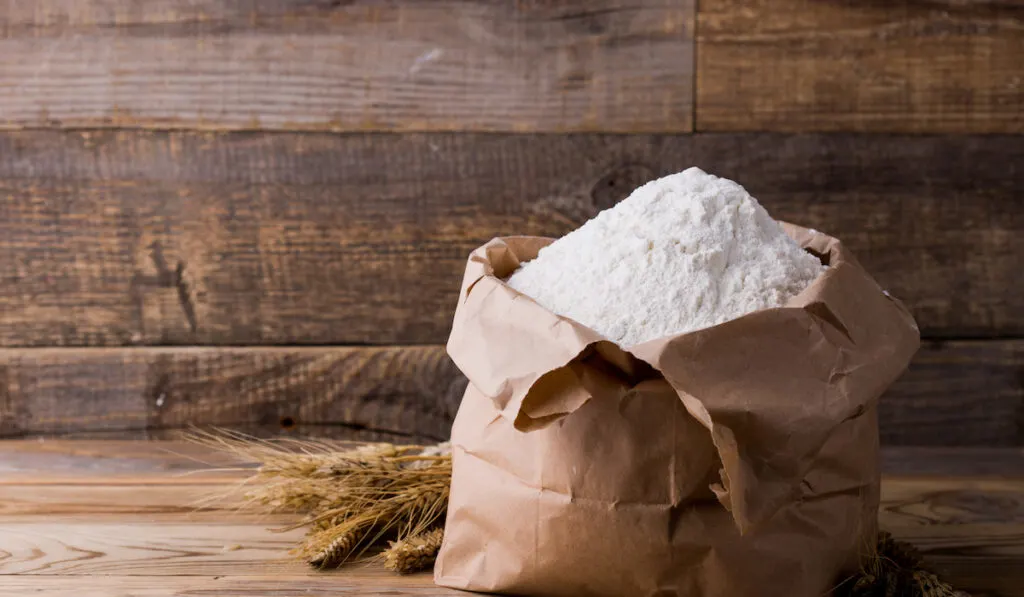Flour is a basic pantry staple that all households should have. Whether you want to use it for baking, as a coating to fry dishes, or as a thickener for your sauce, it is important to know how to properly store it to avoid rancid flour and infestation of bugs.
If you prefer stocking up flour instead of buying in smaller batches, the first thing you should know is the guideline on proper storage to keep flour safe and fresh.
For today’s article, we are going to talk about some of the ways to store flour, as well as some of the most common questions, such as storing it in zip locks and in the freezer. Let’s begin!

Best Way to Store Flour
Keep it in an airtight container
After buying flour, remove it from the package and transfer it to a glass jar or any airtight container. The key to keeping the flour fresh is by preventing it from being exposed to oxygen, since the contamination of flour results from that.
While it is okay to keep flour in their real package, the problem here is once you open the flour and there’s no way to completely seal it again. Aside from that, transferring it into an airtight container will also prevent little bugs from getting into the flour.
Keep the storage area cold
Keep the natural oil in your flour by storing it in a cold place, such as the freezer or the refrigerator. This will help prevent rancidity and will also kill bugs and pests that may have already invaded your flour.
Of course, this works only on a smaller amount of flour, unless you have huge a freezer where you can store big batches of flour.
The storage area should be dark
We know that light generates heat, and it also stimulates oxidation, which is the weakness of fresh flour, by the way. For these two reasons, flour should be kept in a cold, dark place.
Can you store flour in zip lock bags?
Yes, keeping the flour in zip lock bags and airtight containers will keep it safe to use for a long time.
Before sealing the zip lock bag, make sure to remove as much air as you can then store it in a cool and dark space. This will keep pests and moisture from entering the container.
Should you freeze flour?
Yes, if you’re not going to use flour right away, you can keep it in the freezer to prolong its shelf life.
If stored in the freezer, flour can last up to a year. Cold areas, like the freezer, helps in slowing down the deterioration process of flour, thus keeping it fresher as compared to storing it in a warm place.
After buying flour, put it in the freezer to kill any eggs and bugs that may have already been in the flour.

What if I want to store large amounts of flour?
As much as possible, it is recommended to buy flour in small batches since it stays fresh only for a limited time. However, if you happen to buy in huge batches for whatever reason, we’re here to help you out.
If you have huge buckets or containers that can be tightly sealed, then you’re in luck because flour can be safely stored there, provided that it is an airtight container. Otherwise, bugs and pests will find their way to enter the container.
If it won’t fit in your freezer, you may need to find a naturally cool and dark place, such as the garage, cellar, or basement, if you have such.
However, be mindful not to store bagged flour on concrete floors since the moisture from the cold concrete can be transferred into the bag, defeating the purpose of storing it in a cool area.
If you live in a warm climate with no naturally cold areas, you may also store flour inside a cooler or a thermal bag and place it in the coolest spot inside your home.
Lastly, if you have a vacuum sealer, you may opt to transfer the flour into smaller batches and then use a vacuum sealer to properly seal it.
Storing flour according to type
Refined Flours
Some types of refined flour are all-purpose, bread, white, self-rising, and pastry flour. Flour is created by eliminating the germ and bran from the wheat seed before it is crushed, leaving only the endosperm.
The outcome is flour that does not have much oil, and therefore does not spoil easily. It is the type of flour that we usually see in grocery stores. Refined flours are soft and fine in texture, with a color that is white.

Refined flours can last up to a year when stored in a cool, dry place, and up to two years if stored in the freezer. It is recommended to store it in an airtight food-grade container since this type of flour is sensitive to moisture.
Not only will it prevent early spoilage, but it will also block pests and bugs from entering, as well as the smell of other products which can affect the scent and taste of the flour when used.
While it may take a long time for the flour to turn bad, it will smell sour when it does spoil.
Whole Grain Flours
Some types of whole grain flour are quinoa, millet, barley, whole wheat, spelt, teff, ancient grains, buckwheat, oat, rice, amaranth, and medium or dark rye.
Compared to refined flour, this type of flour spoils easier because it retains the bran and the germ, which means more natural oils. While its shelf life is less, whole grain flour contains more fiber and nutrients.
Like refined flours, the whole grain flours should also be stored in an airtight food-grade container to avoid exposure to air. As we may already know, exposure to air promotes oxidation, which is the enemy of any flour type.
Whole grain flour can be stored in a cool dry place and will last 6 months and up to a year in the freezer.
To know if the whole grain flour has already gone bad, you will smell something like burnt rubber or a pencil eraser.
Cornstarch/Corn Flour
Cornstarch, or corn flour, is a flour that is made from the starch in corn kernels. It is used for different purposes, but mostly as a thickening agent in soups, sauces, pies, and gravies.
This type of flour should be stored in an airtight container or glass jar and should be kept in a place away from sunlight. The shelf life of cornstarch is indefinite and can surely be used for a long time if stored properly.

Nut and Other Flours
Some types of nut flour are almond, hazelnut, coconut, rice bran, wheat germ, hemp seeds, and flaxseed meal. Like whole grain flour, this type of flour also has high oil content, therefore, it is prone to becoming rancid or spoiling faster.
Like all other flour types, nut flours should be stored in an airtight container where no moisture, bugs, pests, and air can enter. If stored in the refrigerator, this type of flour can last 6 months, or up to a year if kept in the freezer.
To know if nut flour is still safe to use, it should smell nutty and sweet, otherwise, it has already gone bad and should not be used any further.
With that said, the type of flour plays a huge role in determining its shelf life, although the storage methods are similar to each other.
As mentioned, regardless of any flour type, it is best to pop it into the freezer first for up to 48 hours after opening to kill bugs and pests that may have already been present in the flour. If you think that something is already wrong with your flour, then it is best not to use it anymore.
And that wraps up today’s article! If you find today’s content helpful, please feel free to share it with your family and friends.
Resources:
- https://www.allrecipes.com/article/how-to-store-flour/
- https://www.epicurious.com/ingredients/the-best-way-to-store-flour-article
- https://www.thekitchn.com/a-complete-guide-to-storing-your-flour-204729
- https://homemaderecipes.com/store-flour/
- https://www.thespruceeats.com/how-to-store-flour-1389337
- https://foodsguy.com/freeze-flour/
- https://storagedone.com/
- https://www.tasteofhome.com/article/how-to-store-flour-properly/
- https://www.atcoblueflamekitchen.com/en-ca/how-to/storing-flour.html
- http://www.eatbydate.com/other/baking/how-long-does-cornstarch-last-shelf-life

